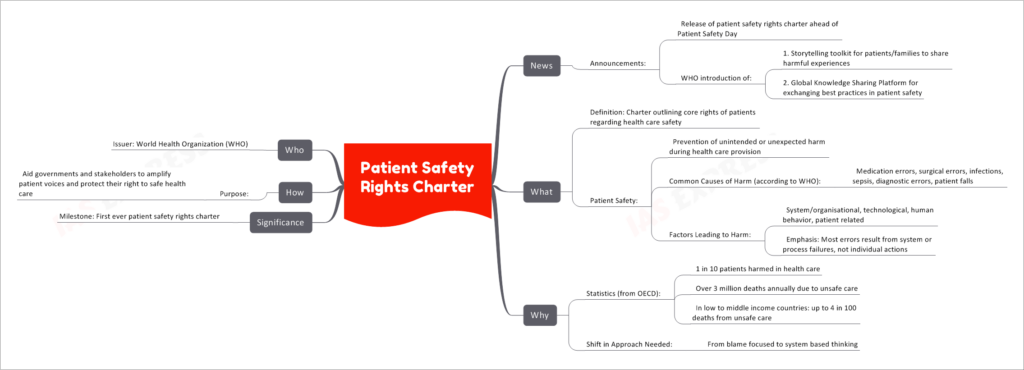Patient Safety Rights Charter

Ahead of Patient Safety Day, the World Health Organization (WHO) has unveiled the Patient Safety Rights Charter. This charter outlines the fundamental rights of patients concerning healthcare safety, and it accompanies the launch of two crucial initiatives by WHO: a Storytelling Toolkit for patients and families to share harmful experiences and a Global Knowledge Sharing Platform for exchanging best practices in patient safety.
Defining the Patient Safety Rights Charter
- Charter Objective: The Patient Safety Rights Charter serves as a document that defines the core rights of patients related to healthcare safety.
Understanding Patient Safety
- Patient Safety: Patient safety in healthcare involves the prevention of unintended or unexpected harm to patients during the provision of healthcare services.
- Common Causes of Harm: According to WHO, common causes of harm in healthcare include medication errors, surgical errors, infections, sepsis, diagnostic errors, and patient falls.
- Factors Leading to Harm: Harm in healthcare can be attributed to various factors, including system or organizational issues, technological aspects, human behavior, and patient-related factors. It’s important to note that most errors stem from system or process failures rather than individual actions.
The Need for the Patient Safety Rights Charter
- Alarming Statistics: OECD data reveals alarming statistics related to patient safety:
- Approximately 1 in 10 patients experience harm while receiving healthcare.
- Over 3 million deaths occur annually due to unsafe healthcare practices.
- In low-to-middle income countries, as many as 4 in 100 deaths can be attributed to unsafe healthcare.
- Shift in Approach: The Patient Safety Rights Charter highlights the necessity of shifting from a blame-focused approach to a system-based perspective when addressing patient safety concerns.
Significance of the Charter
- Milestone Achievement: The Patient Safety Rights Charter represents a significant milestone as it is the first-ever charter explicitly outlining the rights of patients concerning healthcare safety.
Objectives of the Charter
- Empowering Patients: The primary purpose of the Patient Safety Rights Charter is to empower patients and provide them with a clear understanding of their rights in the context of safe healthcare.
Issued by WHO
- Issuer: The Patient Safety Rights Charter is issued by the World Health Organization (WHO), a leading global authority in healthcare.
If you like this post, please share your feedback in the comments section below so that we will upload more posts like this.
